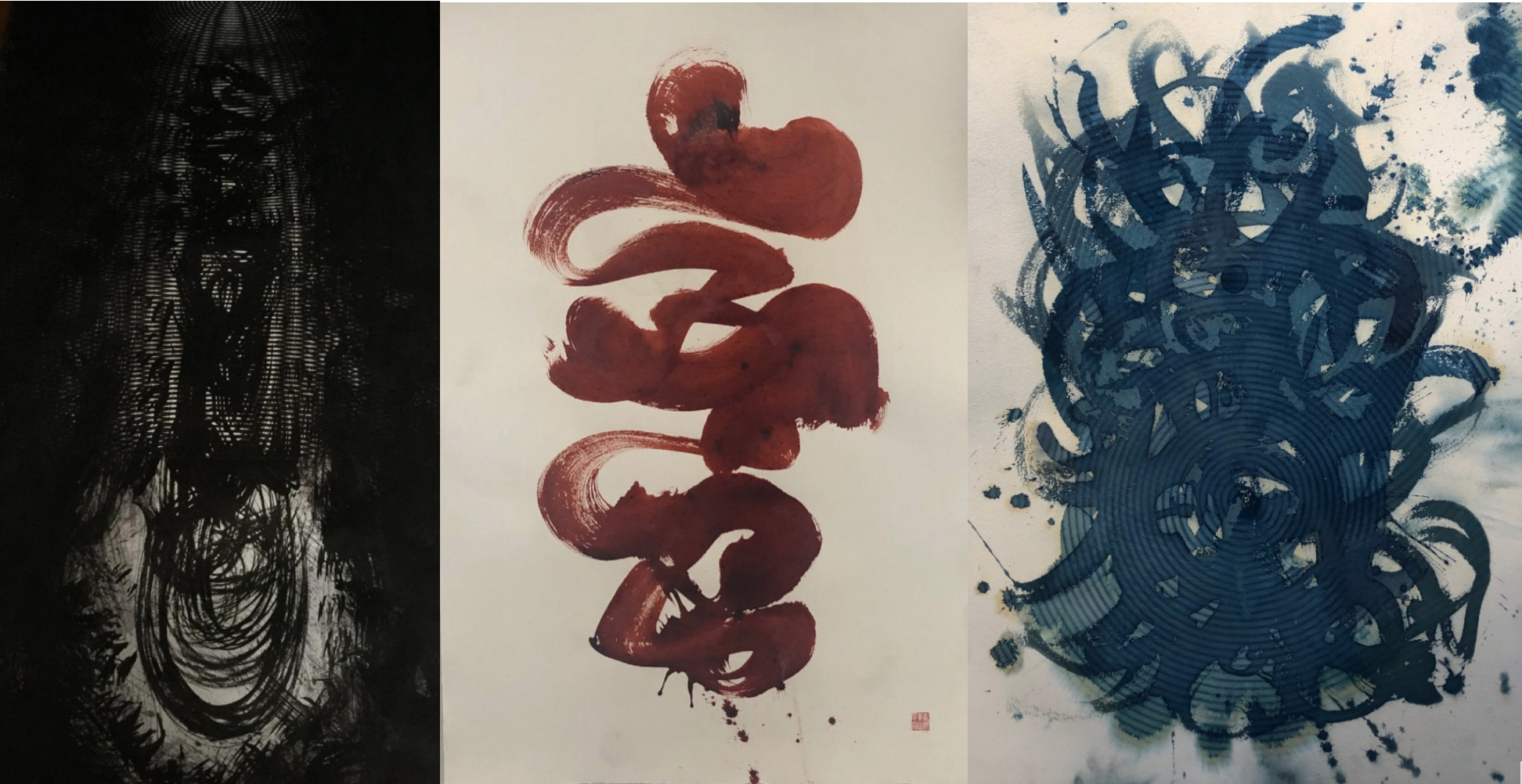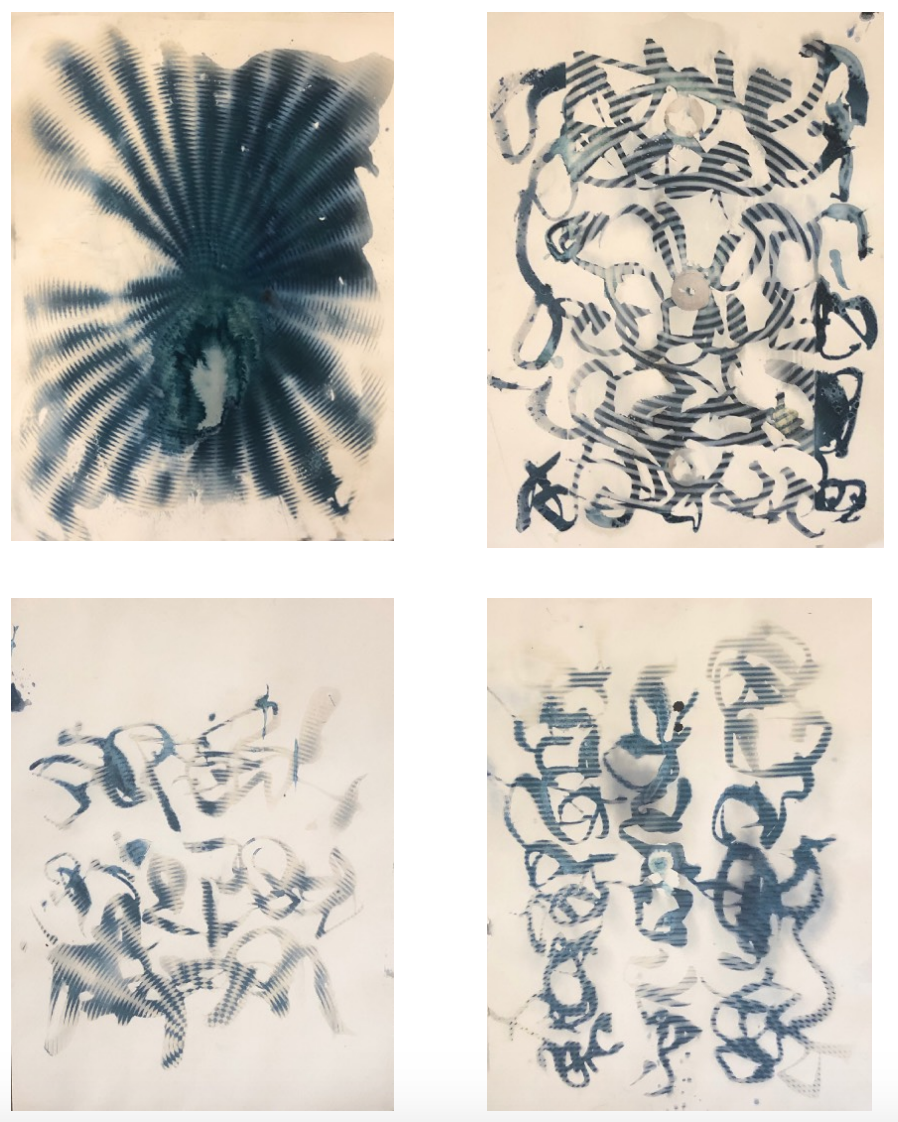
Interview
Three Fires Erupted in Oneself | Enrique Rosas, Uno
by Ricardo Quiroga
At Le Laboratoire
Reading time
9 min
It took more than two decades for Enrique Rosas (Mexico City, 1972) to return to painting. All this time has freed him from that hardening of muscles caused by his profession, architecture. Now he can once again wield a brush on rice or cotton paper, giving release to his characteristic vehemence: his arms let loose as the memories that caused him to return to pictorial art flood to his mind. The gallery Le Laboratoire showcases his most recent work in the exhibition UNO, from September, 5 to October, 11
“Rejoice” is the right word to use in connection with a man so convulsive and restless, exuding a deep gaze and an overflowing smile, who enters the gallery carrying rolls of paper. He is bringing in more of his pieces; he created these after finishing the works that are already mounted and ready for the inauguration.
Visitors to the show will be able to see what Rosas calls “flumos.” This neologism designates the conceptual hybridization of flames (“flamas") and fumes (“humos”), something that passes from idea to rice paper with the use of Chinese ink. The “flumos” are part of the “Black Fire” series, one of the exhibition’s three components, along with “Red Fire” and “Blue Fire.” I will leave it to Rosas to explain his fires to us.

Before Rosas’s arrival, the gallerist Julien Cuisset had warned me, letting out a mischievous laugh: “I’m not going to talk much about his work; I’m going to let him do it himself. He’s a natural, he’s really got it!” Cuisset had also told me that the artist is a great-grandson of Enrique Rosas Aragón, a pioneer of Mexican cinema and the director of one of Mexico’s most iconic silent films, El automóvil gris (The Grey Car), from 1919. The artist grew up among strange cinematic devices, which conditioned his looking at life with curiosity. Rosas spent his years away from painting dedicated to exploring technology’s capacity for serving art; during this time he moved toward kinetic art, toward constructivism, and toward the tricks of cinematography.
Thus was the gallerist—breaking his vow not to betray any detail—just before the artist’s arrival, carrying his roll of “flumos." After placing it on the table in the gallery office, Rosas rolls up his sleeves, standing in front of his works. He knows where each piece has been mounted; he himself helped in the curating. Without fuss, he begins to talk about the work that has brought us together in this space in La Condesa, displaying a skill that lets me see just how right Cuisset was: talking about art is Rosas’s thing.
Ricardo Quiroga (RQ): What was the process involved in making these pieces?
Enrique Rosas (ER): Almost all the pieces were produced on the floor. It’s a technique I saw used in China. I had the opportunity to be invited there by the Chinese government a year ago. I visited three cities and, in one of them, in Xiazou, I met with some masters of calligraphy and painting; they shared their techniques, but in a way that was absolutely fresh, as if by osmosis. There was this skill in their movements, a kind of precision, an almost ritual—and rather ceremonious—attitude toward the piece. They gave me a workspace and material—even though I didn’t go there as a painter—and that lent me the possibility of releasing myself. I had gone almost twenty without taking up a brush because that implies an inner state, a very particular emotional state, that’s different from the neurosis of professional life.
For the Chinese, the ultimate art, standing even above poetry, is painting. That’s because a painter creates a kind of microcosm through their movements, and embodies it, as though replicating it, on paper. For me it became very physical.
I bought a fairly large brush that turned into a kind of baton. It took me all of this year to get to know the instrument. The work practically became a martial art. It forces me to work in large formats, to discover the brushstrokes. Entering the paper is like entering the arena; it’s something rather territorial and very physical. Chinese theory says that you need to pre-visualize what you’re going to paint, but in reality, at least in this first instance, what I did was empty myself out completely. Through these movements I’ve awakened a kind of amniotic memory. Through it, I can reveal myself, reveal a personal stroke.
RQ: How did you get there? What led you to that moment of revelation, that of returning to painting?
ER: It’s very curious because my artistic work has always been a practice deriving from the dialogue between memory and perception.
I could link the perception part to the tradition of kinetic, optical, and geometric art, with influences from figures like maestro Carlos Cruz-Diez or Julio Le Parc, but also to the aesthetics of Mexico in 1968. Although I was born in 1972, I could almost say that I was born in 1968. Almost my whole generation obeys the spirit of that time.
As for memory, I come from a family that has been dedicated to cinematography for over a hundred years. The first Mexican film [El automóvil gris], properly speaking, was made by my great-grandfather. We share the same name, and that’s brought about certain implications. I grew up around pizcacha [fragments of scrap film] and moviolas [machines for editing films]. I have worked with the phenomenon of retinal resistance: a repetition of similar things that, from the deception of the senses, produces the illusion of movement. It’s something that happens here too.
Black Fire
Rosas walks towards the series of eight “flumos,” measuring 135 by 40 centimeters, framed and aligned next to each other on a single gallery wall, all in Chinese ink on rice paper. The “flumos” resemble the whimsical, never stationary—and never identical—flames of a match. Then Rosas points out the rest of the pieces made with the same technique, but in a larger format. Some are vertical, from floor to ceiling; others are horizontal, running almost two meters long. The latter have not been framed, as Julien Cuisset explains to me, in order to give them an imposing presence in the gallery. These larger pieces take still other forms; there are geometric exercises, executed by Rosas’s two hands, and other pieces that resemble clouds of knotted lines.
It’s as if the fire became many different signs. And although there are many different signs, the fire is only one. Hence the title of the exhibition. ER.
Rosas takes a step back in order to demonstrate his work process from top to bottom. He moves his arms as if shaking an invisible concoction. He shows how he has wielded the brush in order to render his work concrete. He opens the compass of his legs like someone warning that he’s about to execute a capoeira move. He constantly looks up in order to make sure that we’re following the demonstration. He remembers that he has brought with him the brush with which he has worked on most of his three series, and at that moment he briefly abandons the conversation in order to pick it up. Brush in hand, he urges us to get to know the rest of the two series that make up UNO.
Red Fire
First he presents his “Red Fire,” boasting four large-format pieces in red and scarlet tones; then, another elegant piece: small, with a vivid, hypnotic red, its ink made from cochineal grana.
RQ: What does “Red Fire” mean to you, in contrast with the rest?
ER: This series was cathartic, an explosion. The truth is that this exercise consumed me. Let’s just say that I’m learning to go through the fire without carbonizing.
RQ: With this guideline of fire, I understand that you wanted to experiment with other materials, to dig through other processes of combustion, but how did you arrive at the cochineal grana?
ER: As it happens I started working with grana about four or five years ago. I was commissioned to do a work for charity and they gave me cochineal grana. I started experimenting with it and I went crazy. I loved seeing how the live material reacted with the chemicals. From there I started exploring circular movements and making splashes with a cloth; it was all very vivid because it also coincided with the death of my best friend. One of the pieces that I was making took on a very symbolic meaning. Later, when I went to China I got this brush that allowed me to cover such a huge space, expanding across the papers. It was so beautiful.
Blue Fire
The series “Blue Fire” is made up of ten small- and medium-format blueprints. There is even more complexity in this last exercise. Rosas has poured into each piece the calligraphy exercises he learned in China, the photographic exercises he has known since childhood, and the artistic exercises concerned with geometry that he had executed before his return to painting. In this last work there is layer upon layer of the artist’s personal memory.

RQ: How did you get the blueprint to work in this last series?
ER: The combined reagents are UV sensitive. The shadow of an object operates as if it were a negative. I spray or paint the substrate with the brush, I expose it to the sun, and then I place a negative; in this case, they’re negatives of previous exhibitions pieces. It’s the UV rays that bring out the blue, and are finally set using water. It’s like a calligraphied blueprint.
Here you see my fingers. What might earlier have seemed like errors, like these finger stains, are now for me not errors at all. I’ve emptied myself of that tidiness in order to make something more wild, more vivid. The pieces are the result of the imprint of the sun plus my own imprint with the brush.
RQ: When it comes to expressing yourself you’re very physical. When you unwind the papers and paint, you physically return to that moment—at least in terms of gestures.
ER: Making these pieces has been a catharsis. I just shattered. I gave myself up physically. It’s like going out on the field to kill. I felt candid here. I had been very immersed in computers, I had always been very enthusiastic about technology, but there not everything depended on me; in this, it was just me facing the paper, without any kind of neurotic suffering. It’s all about discovering the secrets of the material and using the support to get to know yourself
Published on September 11 2019